You’re watching a newt glide through the water, and you might wonder, if it stays too long underwater, can it actually drown?
Yes, newts can drown, even though they are great swimmers. Their skin helps them take in oxygen, and they can use lungs or gills depending on their stage of life. But if the water is low in oxygen, or if they can’t reach the surface, drowning becomes possible.
It might sound surprising, but it makes sense once you see how their bodies work.
Why Amphibians Like Newts Need Air Too
Newts are amphibians, which means they split their lives between water and land.
Unlike fish, they don’t keep gills their whole life.

As larvae, they do have gills. But adult newts mostly rely on lungs and skin to breathe.
That’s where the challenge starts. If the water has low oxygen, or if they get stuck underwater with no way up, they can’t get what they need.
Even in water, air is still very important.
How Do Newts Breathe Underwater?
Newts are interesting because they don’t rely on just one way to breathe.
They have several systems that work together.
- Skin breathing (cutaneous respiration): Their skin is thin and moist, so oxygen passes in and carbon dioxide passes out.
- Lungs: Adult newts still have lungs. They swim up to the surface to take a gulp of air when needed.
- Larval gills: When they’re young, they have feathery gills that take oxygen from water.
This mix usually works well. But none of it can save them if oxygen gets too low or they can’t reach the surface.
Can a Healthy Newt Drown in Clean Water?
You might think: if the water is clean and full of oxygen, could a healthy newt drown? It’s rare, but yes, it can happen.
For example, if a newt gets trapped under a rock or thick plants, it might not reach the surface to use its lungs.

And if the water is still, even skin breathing might not be enough.
So even in good conditions, physical barriers can create real danger.
Poor Water Quality Makes Drowning More Likely
Imagine a pond full of algae or a tank that hasn’t been cleaned for weeks. The water might look okay, but oxygen could be low.
In these situations, newts that rely on skin breathing can run out of air.
They may struggle, float weakly, or even drown if things don’t change.
This is why tanks with newts always need aeration and clean water.
Nature usually balances itself with moving water and plants, but tanks need our help.
Do Newts Know When to Come Up for Air?
Yes, they have instincts. You’ll often see a newt swim up, poke its head above the water, and take a gulp of air.

But here’s the catch: if they’re stressed, weak, or caught in strong currents, they might not make it.
Instincts only help as long as their body can respond.
Can Newt Eggs or Larvae Drown?
Newt eggs and larvae have their own challenges. Eggs get oxygen through the jelly around them.
If the water is still, they can suffocate.

Larvae use gills, but if oxygen is low, they can struggle too.
You’ll often see them in shallow water near plants or gentle streams. Even at this early stage, oxygen is very important.
Do Newts Drown More Often in the Wild or Captivity?
In the wild, healthy newts drowning is uncommon. Streams, ponds, and marshes usually have enough oxygen and resting spots.
Captivity can be tricky. Tanks might have still water or too few resting places. That’s when drowning becomes more likely.
Why Do Sick or Injured Newts Drown Easily?
A strong, healthy newt can swim up for air easily. But a weak or injured one may struggle.
For example:
- If a newt has a skin infection, it might not absorb oxygen as well.
- If it’s sick and weak, it might not have the energy to reach the surface.
- If it’s stressed by chemicals, pollution, or handling, it might not respond normally.
In these cases, even safe water can be dangerous.
What Can We Learn From Their Risk of Drowning?
The fact that newts can drown reminds us that their lives are a delicate balance.
They’re neither fully aquatic nor fully land creatures. They need both worlds, and losing balance in one can lead to danger.
It also shows how much their survival depends on the environment.
Clean water, enough oxygen, and safe resting spots all matter.
Conclusion
So, can newts drown? Yes, they can, even though they’re natural swimmers with special ways of breathing.
Their skin, lungs, and sometimes gills all work together to keep them alive, but they’re not invincible.
Poor water, lack of access to the surface, or sickness can all tip the balance.
In the wild, nature usually gives them what they need. In captivity, it’s up to us to make conditions safe.
It may seem strange that a water-loving creature can drown, but it’s a clear reminder of how carefully balanced their lives are.
Hi, my name is Ezra Mushala, i have been interested animals all my life. I am the main author and editor here at snakeinformer.com.

